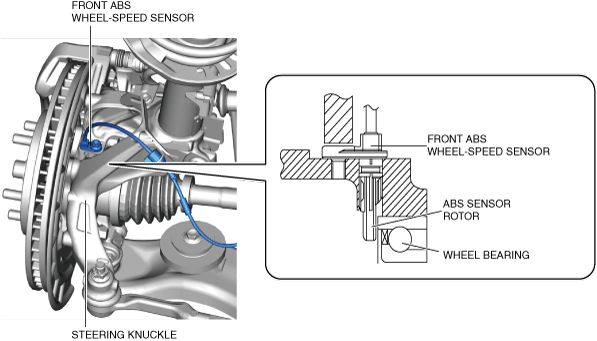ABS WHEEL-SPEED SENSOR AND ABS SENSOR ROTOR
id041900702400
Purpose, Function
• The ABS wheel-speed sensor and ABS sensor rotor detect the rotation condition of each wheel and transmit this to the electronically controlled brake unit as a wheel speed signal.
• The wheel speed signal from the ABS wheel-speed sensor is the primary signal that the electronically controlled brake unit uses when carrying out control.
Construction
• The ABS wheel-speed sensor utilizes a semi-conductor element that contains an active drive circuit (MR element*). The front sensor is installed on the steering knuckle and the rear sensor is installed on the wheel hub.
• The front ABS sensor rotor utilizes a magnetic encoder system that functions with magnetic rubber, and is integrated into the front wheel hub. Therefore, if there is any malfunction of the front ABS sensor rotor, replace the front wheel hub.
• The rear ABS sensor rotor utilizes a magnetic encoder system that functions with magnetic rubber, and is integrated into the rear wheel hub. Therefore, if there is any malfunction of the rear ABS sensor rotor, replace the rear wheel hub.
*: A magneto-resistive force means that an exterior magnetic field acts on the element, changing the resistance of the element.
-
Caution
-
• When inspecting the ABS wheel-speed sensor, do not use an ohmmeter to inspect resistance. It is possible that the voltage from the ohmmeter could damage the semiconductor inside the ABS wheel-speed sensor. Perform the PID/data monitor inspection using the M-MDS.
-
Note
-
• Magnetic encoder: A plate that has positive and negative poles (marked out) in a continuous, alternating line.
Front ABS wheel-speed sensor and ABS sensor rotor
Rear ABS wheel-speed sensor and ABS sensor rotor
Operation
• As the ABS sensor rotor rotates, the magnetic flux between the ABS wheel-speed sensor and the ABS sensor rotor change periodically. This periodical change appears in proportion to the rotation speed.
• The semiconductor element in the ABS wheel-speed sensor detects the change in magnetic flux, and the active drive circuit converts it to a rectangular wave signal, which is transmitted to the electronically controlled brake unit.
• For every single rotation of the ABS sensor rotor, 48 rectangular wave pulse signals are output. The CM part of the electronically controlled brake unit calculates the wheel speed from the periodicity of these pulses.
